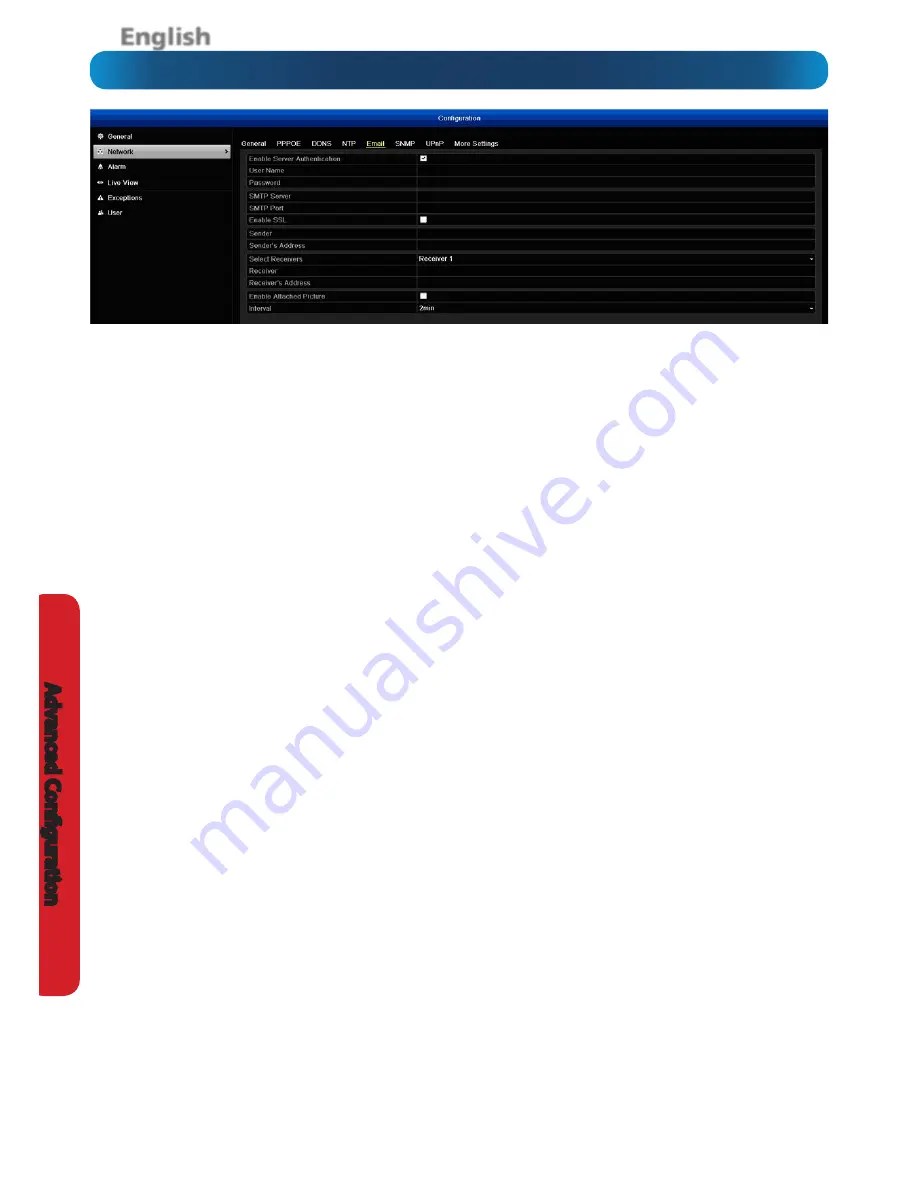
English
40
A
dv
anc
ed C
onfigur
ation
Configuration: Network: Email
We suggest using Gmail as your email client - it’s quite easy
to set up an account and use it solely for the DVR. We’ve
tested the email procedure with Gmail, and it does work.
Other email servers may not work correctly - many
interpret the procedurally generated email from the DVR
as
spam
and block the mail from being sent.
For the Auto-Mail function to work correctly, the DVR will need
to be correctly configured with the details of the email servers
and addresses you want to use.
Enable Server Authentication:
If your outgoing mail server
requires authentication, ensure this box is checked.
Sender Username / Sender Password:
The username and
password for the outgoing email account.
SMTP Server:
The name of the SMTP server of the email
provider that you have selected. Here are the SMTP server
names for Gmail (Google), Yahoo Mail and Windows Live Mail
(Hotmail):
Gmail (Google):
smtp.gmail.com
Yahoo Mail:
smtp.mail.yahoo.com
Windows Live Mail (Hotmail):
smtp.live.com
You’ll need to setup an account with one of these email
providers. All offer free email accounts. To signup, visit the
email provider’s website:
Gmail (Google):
www.gmail.com
Yahoo Mail:
www.mail.yahoo.com
Windows Live Mail (Hotmail):
www.hotmail.com
SMTP Port:
The SMTP port used by the email provider of your
choice. The SMTP port for Gmail users is
465
.
Enable SSL:
Whether the email server you’re using requires
a secure link. This should be left on if you’re using any of the
preset email servers.
If you want to use your ISP’s outgoing email, then you’ll need to
contact your ISP to learn the correct values for the other fields
(such as the correct
SMTP server
,
SMTP port
,
SSL
requirements
and so on).
Sender’s Address:
The address you’re sending the email
from
. This will be the username you’ve set up for the email
server you’re using, followed by “@” and then the email server.
For example: “[email protected]” or similar.
Select Receivers:
You can select up to three different receivers
to send an email to.
Receiver’s Address:
The email address you want the DVR to
send emails to. This can be any email address you like, however,
bear in mind that the DVR might send a large number of
automatic emails under certain conditions.
Enable Attached Picture:
When this is selected, the DVR
will attach three small images to each email alert (where
applicable).
For motion-based email alerts, this will be an image of
whatever triggered the motion detection.
Interval:
The length of time that must elapse after the DVR
sends an email alert before it will send another.
Short
Interval
settings are likely to lead to huge numbers of
alerts being sent by the DVR - perhaps even several emails
for one event (if that one event lasts longer than the interval
setting). On the other hand, a long interval setting might
mean you’ll miss a specific update that you needed. There’s no
right answer, and you’ll probably have to fine-tune this setting
to get the results you’re after - it’ll be different for everyone’s
unique circumstances.
Name for sender account
smtp.gmail.com
465
outgoing@email address
Name for receiver account
receiver@email address






























